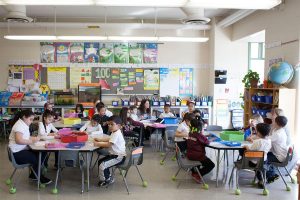Adjustment to Online learning

On March 17, my life was forever changed as my college, North Carolina State University choose to continue the rest of the spring 2020 semester online due to the pandemic known as COVID-19. In the course of a week, I was required to drive to NC State and pack up my belongings to move back home to New Jersey for the rest of the semester. At first this transition was extremely hard for me as I was moving back home and would no longer be able to see my friends as well as my professors who I have made strong connections with throughout the course of the semester. In addition, I no longer had my set daily routine of going to class, going to dance practices for my dance team, and completing work. Overall, I felt completely lost as my life changed in the course of the week, and my university transitioned to online learning. As time progressed I was able to adjust to the “new normal” of online learning as I completed assignments, attended classes, and worked extremely hard to complete my second semester.
Although COVID-19 has halted life as we know it, it is important to reflect upon the various people that are helping to better the current situation. Healthcare workers, like my mother, have been working diligently to ensure every patient is cared for, even if that means staying away from family or loved ones. Grocery store workers have been placed on the front lines, restocking empty shelves with food and other essentials. However, one of the most important and valuable workers during this time is not on the front lines, instead they are educators advocating for their students. Teachers, administrators, and other facility have been going above and beyond their call of duty during this time, as they are required to not only educate students but support parents, or other guardians in the schooling of their children. Educators who care for their students deeply are doing everything in their power to champion the health and well being of their students as well as provide a sense of comfort to young children who may not fully understand the gravity of the pandemic. Overall, the shift in online learning may be difficult for all but educators are pushing through so that they can advocate and support their students.
Education Before COVID-19
Before the outbreak started, students would attend school everyday learning various subjects from their teacher(s) in a classroom setting. They would be able to collaborate with other students through class discussions, group work, as well as projects, developing social skills and creating emotional connections with peers. Teachers were able to educate their students in various ways including hands on activities in class, lectures, or providing individualized feedback. Every day, students would receive instructions by educators on assignments to they were required complete in class as well as the means to do each assignment such as worksheets, handouts, or readings. In some school settings, students were allowed to use classroom or personal technology such as iPads, Chrome books or Macs to complete work. Although many students and teachers used various forms technology in everyday classwork, it was not the sole tool of education in the classroom.

With the outbreak of COVID-19, many teachers were forced to adapt to a “new normal” of online education, relying solely on technology to instruct their students. As the outbreak became more serious and the imminent closure of schools approached educators were forced to ask themselves several questions including:
- How will my students complete work online?
- What kind of technologies will my students have access to at home?
- What can I do if some of my students do not have access to the internet?
- How will I deliver the content of my classroom in the new online format?
- How can I emotionally support my students through online learning?
The “New Normal” of Education
As a result of the pandemic, educators are using various technologies and other new resources to educate their students. In this “new normal”, educators have been using technology to keep their students engaged and conduct meaningful lessons. The way students are being taught varies by state, county and district as a direct result of technology or resources available for each pupil.

For instance, at North Carolina State University, my teachers have been using the platform Moodle to assign projects, and lessons throughout each week. Each of my assignments is given with instructions as well as the time frame we are expected to complete the assignments. In addition to Moodle, several of my instructors have used Zoom to communicate with students as well as hold class. This tool is excellent as I have been able to connect with my professors and classmates while being over 500 miles away from Raleigh.
At the K-12 level, my home district has been using various technologies to connect with students of all ages. Being one of the most heavily impacted areas of the coronavirus, schools in Monroe Township, NJ are closed indefinitely under the governor’s orders. The entire district is using online learning for the time being. Students at the high school level have personal iPads already as the school gives students this type of technology for learning. High School students are required to use the app schoology to complete assignments during times at which they would have class. Students can communicate with teachers through the chat function on schoology or through their school email. At the elementary school level, teachers are using applications such as google classroom to give their students virtual assignments. They are also communicating with students and parents through their personal class websites which they can post information as well as other types of work they want students to complete. From speaking with my sister who is a student at the high school as well as other friends who are also still in high school, I think online learning is working well. However, there are some technical difficulties. So far my sister has had very minor problems in completing her work as the app schoology has already crashed once.
Coming from a wealthier district many students have access to technology in their homes, however, poorer districts may have trouble copping with the effects of COVID-19 as many students may rely on school as a safe haven. Students may come to school for food as well as to escape abusive relatives or a bad home situation. From discussing with my friends that live in North Carolina, many schools in poorer areas are helping students by providing free meals, as well as packets of work for students who may not have access to the internet.
To learn more about my former school districts online learning click here!
Technology and Other Helpful Resources in Navigating Online Education
Here are some of the technologies and applications that have been helpful in navigating online education:
- Zoom: A free video chatting service that allows users to connect with one another. In this application, teachers can present their screen or share activities and can chat with the class through the chat function. In addition, the service also allows students to interact with one another as educators can make individualized breakout rooms. This technology has worked great and I use it to attend several of my classes including ECI 201 online.
- Google Docs: This is a free service through google, if you create or have an existing google account. Through this service you can create documents and share with others. I have used this program to take notes in college and it is great as I can easily share them and collaborate with others. This service is especially useful for group work or projects as multiple students can work on the document at once.
- Google Hangouts: This program allows users to chat one another in real time as well as video conference. Students can use this technology to receive real time feedback from teachers as well as communicate with other students face to face.
- Google Keep: This is a tool in which you can create reminders, to do lists or pictures to stay organized. I love using this tool as I can layout what I need to do each day as well as write down the important assignments I have due each week.
- Quizlet: A free online quiz service in which students can create their own flashcard sets or choose from other pre made sets. This application has multiple features including computer generated practice tests that students can use to review material.
- Brainpop: A source of educational videos on various topics that also include quizzes for students to complete.
- Flipgrid: Through this program students can collaborate with their teacher by posting their own ideas on the topic at hand or commenting on other students videos.
- Zoom
- Google Docs
- Brainpop
My Tips for Spending Less Time on Technology
Everyday I spend hours on my laptop, straining my eyes and often getting large headaches from staring at a screen. Here are my suggestions for other activities to do besides spending time on screens:

My dog Cruz!
- Read a good book: I love reading a new book, they can transport you into a new world or educate about topics which people are unfamiliar with. Some of my favorite books include the Harry Potter series by JK Rowling, The Book Thief by Markus Zusak, and The Kite Runner by Khaled Hosseini.
- Go for a walk: Getting fresh air and exercise is great for the body. Be sure to stay 6 feet away from others and wear a mask as the virus may linger in the air for several hours.
- Draw or Color: Drawing or coloring is a great way to pass time and get super creative. For some people this activity can be extremely relaxing!
- Start a new hobby or try something new: Now is a great time to start a new hobby as everyone is stuck at home. I personally have been trying to teach myself how to sew, which is not going to well at the moment, but I have so much time to keep trying!
- Connect with friends and family: This one requires a little bit of the use of technology but checking on others is extremely important during this uncertain time.
- Play with Pets: I love spending time with my dog Cruz. He gets so excited when I take him for walks as well as play with him in my backyard
Conclusion
As a result of COVID-19, everyone has had to adjust to a “new normal”. Although this time is extremely trying emotionally, mentally and physically, it is essential that everyone works together by staying home and socially distancing from others. Despite the many negative changes that have occurred over the past few months, educators still remain an integral part of society as they work to advocate for all students as well as provide comfort in this time of need. As a future educator, I admire all the efforts of teachers who have gone above and beyond the call of duty to bring students light and happiness in very dark times. This situation has made me realize the impact and importance I will one day have on my students as I hope to establish connections with every single child. The situation has also brought to life the importance of technology in the classroom setting as majority of student work is being assigned online in various softwares. As a future educator, I plan on instructing my students on how to use tools such as Flipgrid, as well as Brainpop, so they can be prepared if schools were required to solely rely on technology in the future. Despite the scary time we are currently in, educators provide students much needed comfort, while at the same time advocating for every one of their students.



